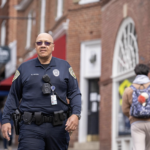
University Police Department officer Wallace Goode patrols along the Corner district on March 14th. (Photo by Sanjay Suchak, University Communications)
by James C. Sherlock
The University of Virginia has to be careful what its officials say because of the ongoing lawsuits over the November massacre. But the school is taking concrete steps to address the spike in violent crime in Charlottesville.
I congratulate them.
UVA Today ran an article on those initiatives on March 15th.
In the early morning hours of March 18, a UVa contractor was shot and killed across the street from the Rotunda.
More needs to be done, but carefully.
The crime problem. As tallied by The Daily Progress, a killing on Elliewood Avenue on March 18th at the Corner district adjacent to the University of Virginia on Saturday morning brought to 14 the number of firearm-related killings, with 22 injured in the Charlottesville area since September of last year.
Three of those victims were killed and two injured in the infamous mass murder at the University in November.
Elliewood Avenue is immediately across the street from the University’s slave memorial and right down a hill from the Rotunda.
The University of Virginia Police Department issued a shelter-in-place order at 2 a.m. on Saturday morning and lifted it about an hour later.
That brought to 13 the number of UVa safety alerts so far in 2023, including one attempted robbery, one robbery, five incidents of shots fired, one disorder with a weapon and one shooting, with the murder on Elliewood not yet in the safety alert database when I researched it.
Based on state data, the chance of becoming a victim of violent crime in Charlottesville (population: 45,000) was 1 in 187 in 2021, compared to 1 in 440 state-wide. But there were no Charlottesville killings reported in FBI data in 2021.
Unless the reports are disconnected, the city went from zero killings in 2021 to 14 in the last seven months. That is the violent crime spike the University is trying to address.
The University Police crime log is available online, as of November 2022. And I am not just talking about the triple homicide.
University Police handle more serious crimes with more regularity now than many, including me, have understood.
University initiatives.
Police Coordination. The administration reported to the Board of Visitors that the University had implemented several initial changes in response to November 13 and regional gun violence.
In addition to generally increased local, regional and state cooperation, they coordinate on real-time crime data to update models of trends and allocate resources accordingly.
Such coordination is critically important, especially with the shortage of law enforcement officers (LEOs).
I credit University Police Chief Tim Longo, former Chief of the Charlottesville Police Department, for that initiative.
Student Ambassadors. In cooperation with Charlottesville Police, the University has used its concurrent jurisdiction agreement to expand its Ambassador program into student neighborhoods adjacent to the Grounds in an attempt to increase visibility and reduce crime.
The Ambassadors wear bright green vests and are unarmed but in direct contact, presumably with police communications equipment, with University emergency dispatch.
One of those neighborhoods is the Corner district, where Ambassadors patrol in late-night hours. This is where the latest murder just occurred — late at night. The Ambassadors connect students with Safe-Ride or walk with them to their destinations.
The University and the Ambassadors accept the risk to improve overall outcomes. I congratulate the Ambassadors for their dedication and bravery.
But I think the University is taking a risk with students it may regret all too soon.
Threat Assessment Team. An independent review of the facts surrounding the November triple murder was requested of the Attorney General by the Board of Visitors. It is ongoing. From the UVAToday article:
The University plans to use those independent findings to understand more clearly what happened, and to identify what processes to improve for the future.
UVA officials already have made some changes since Nov. 13 to the processes of the threat assessment team
The article did not specify those changes, which is what I was looking for in the piece. I suspect they did not want to provide ammunition to the victim family attorneys.
Yet Tim Longo, University Associate Vice President for Safety and Security, Chief of Police and the head of the University’s Threat Assessment Team, chose to argue his case in that article.
Because the University’s current policy is administrative and a violation would not result in criminal liability, law enforcement does not have the full range of investigative and enforcement options that are typically associated with violations of criminal law, Longo said. One example would be the ability to obtain a search warrant when officials have probable cause to believe a firearm is inside a dorm room.
Currently, non-law enforcement officials could be called upon to look into suspicion of a firearm in such spaces, potentially putting them at risk.
I find it unfortunate that Chief Longo chose to publicly offer a defense ahead of the report of the investigation.
That investigation is charged specifically to look into exactly what the Threat Assessment Team did and did not do and could and should have done in that case.
Bottom line. The increased coordination with local, regional and state law enforcement is a good move and a welcome one.
The use of the Ambassadors off Grounds is both brave and risky.
On the threat assessment team issue, I have pledged to not repeat earlier criticisms pending the investigation report.
Chief Longo should consider leaving it alone as well.


